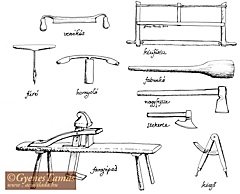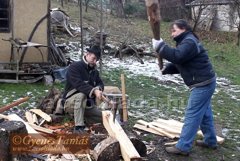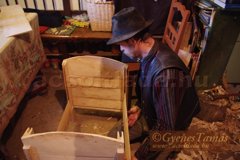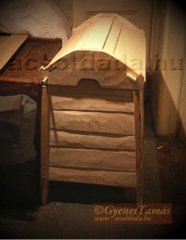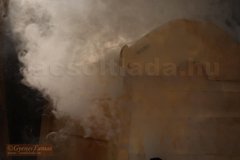The construction of riven chests, their tradition stretching back over many centuries, is a lengthy and exhausting process. Though construction methods have been quite well known
in the whole of Europe and even in some parts of Asia, this knowledge has in the last approximately 200 years fallen into oblivion. The only artisans preserving this tradition
have been folk craftsmen of the Carpathian Basin, who during the last heyday of riven chests in the years between 1820 and 1920 have produced thousands of such hand-riven chests
with beautiful, diverse ornament ( a form of symbol writing ).
Gyenes Tamás, acsoltlada.hu
The whole building process being hundreds of years old, when constructing a chest, I only use the simplest tools you can see in the side image. I seek out the right beech tree
that will split well. Beech has been used for centuries in these lands, sometimes oak, too, but only to a minor extent, especially in the Hungarian Lowlands.
The logs are sawn into smaller pieces and the first step involves splitting them into quarters. These quarters have to be then split into smaller and smaller parts until
arriving at the thickness of the boards needed. The rough surface of the split boards is then hewed with a hatchet, taking out most of the unevenness.
After this I start cleaning up their surface with a drawknife. This step is the most often repeated, but the most important step of chest making: you need only
a shaving horse and one or two good draw knives, but every board has taken out of the shaving horse many times, checked for thickness and for form by eye,
put back again into the shaving horse, and you shave off some more here and some more there - and so on. And to make an average riven chest traditional in my area,
the "Palóc" region, you will need approximately between 32 and 38 boards!
After long hours at working with the draw knife, the boards have to be furnished with a groove on their thicker side, again of course by hand. The thinner sides of
the boards sliding into these grooves will make up the side panels of the chest. I prepare the legs of the chest first and then fit in the side panels.
The beech boards will need joinery with pegs - I hand-carve these wooden nails, too. The two side panels will hold the base boards and the boards of the front and back boards of the chest.
The lid of the chest is hinged on supports protruding from the uppermost board of the back panel. After the side panels of the lid are made, the uppermost ridge board
and the other roof boards have to be prepared. The lid has to be joined without tensions, put together very tightly and then mounted on the body of the chest.
Has the riven chest been thus assembled, the next step is the traditional smoking. Smoking might take half a day and is a process that has to be watched closely during the whole time.
The smoked surface is then treated with a natural stain and the patterns cut into this surface. I embellish the patterns in the manner of the old masters.
I have been studying many riven chests of the past in detail to get to know the principles of construction of the patterns and the symbols that occur.
Based on these graphic marks and following the tradition of workshops of olden times, I plan the whole composition. The resulting ornate chest is therefore never
a mechanical copy but still quite similar to the riven chests of the past - it is meant to be their organic continuation.
Many of the graphic symbols have meaning – you can find descriptions of some symbols in my book.
To date, I have built more than 120 riven chests in the traditional way of construction, using traditional tools.
I have been studying old chests of the Hungarian Basin kept in museums and private collections for many years and have also restored many chests in the same manner,
with the same tools and appropriate materials.

Gyenes Tamás's riven wood chests and folk-flutes
